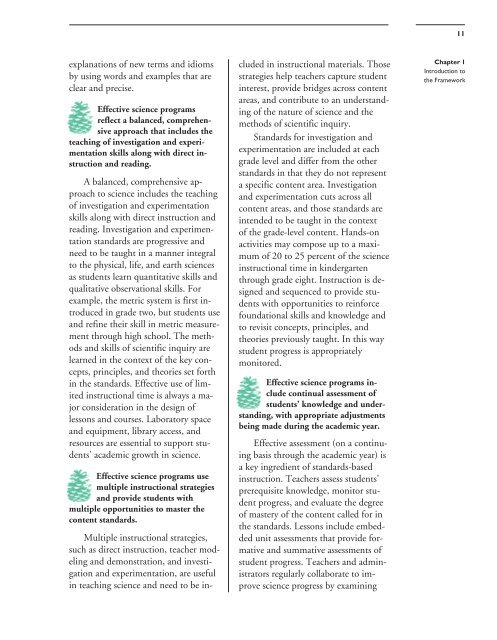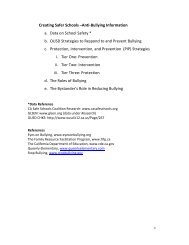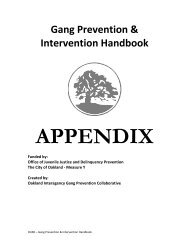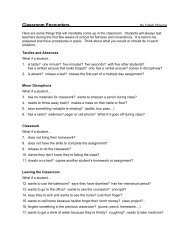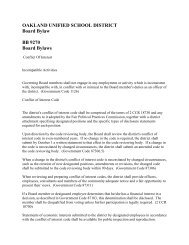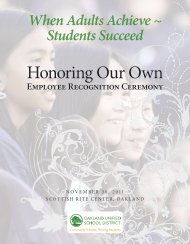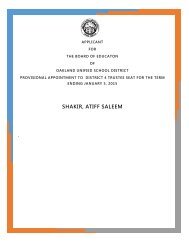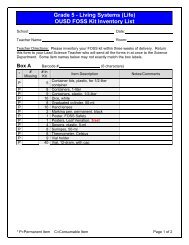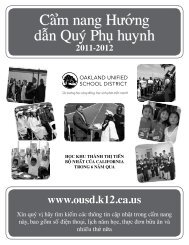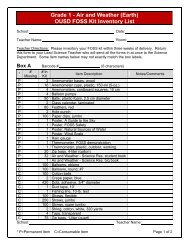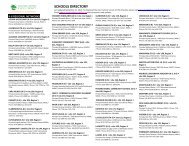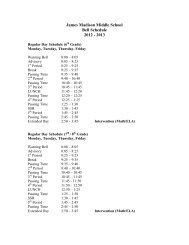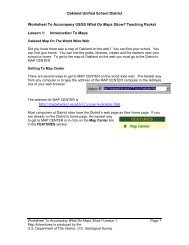Science Framework, part 1 - Free Downloads (CA Dept of Education)
Science Framework, part 1 - Free Downloads (CA Dept of Education)
Science Framework, part 1 - Free Downloads (CA Dept of Education)
- No tags were found...
You also want an ePaper? Increase the reach of your titles
YUMPU automatically turns print PDFs into web optimized ePapers that Google loves.
11explanations <strong>of</strong> new terms and idiomsby using words and examples that areclear and precise.Effective science programsreflect a balanced, comprehensiveapproach that includes theteaching <strong>of</strong> investigation and experimentationskills along with direct instructionand reading.A balanced, comprehensive approachto science includes the teaching<strong>of</strong> investigation and experimentationskills along with direct instruction andreading. Investigation and experimentationstandards are progressive andneed to be taught in a manner integralto the physical, life, and earth sciencesas students learn quantitative skills andqualitative observational skills. Forexample, the metric system is first introducedin grade two, but students useand refine their skill in metric measurementthrough high school. The methodsand skills <strong>of</strong> scientific inquiry arelearned in the context <strong>of</strong> the key concepts,principles, and theories set forthin the standards. Effective use <strong>of</strong> limitedinstructional time is always a majorconsideration in the design <strong>of</strong>lessons and courses. Laboratory spaceand equipment, library access, andresources are essential to support students’academic growth in science.Effective science programs usemultiple instructional strategiesand provide students withmultiple opportunities to master thecontent standards.Multiple instructional strategies,such as direct instruction, teacher modelingand demonstration, and investigationand experimentation, are usefulin teaching science and need to be includedin instructional materials. Thosestrategies help teachers capture studentinterest, provide bridges across contentareas, and contribute to an understanding<strong>of</strong> the nature <strong>of</strong> science and themethods <strong>of</strong> scientific inquiry.Standards for investigation andexperimentation are included at eachgrade level and differ from the otherstandards in that they do not representa specific content area. Investigationand experimentation cuts across allcontent areas, and those standards areintended to be taught in the context<strong>of</strong> the grade-level content. Hands-onactivities may compose up to a maximum<strong>of</strong> 20 to 25 percent <strong>of</strong> the scienceinstructional time in kindergartenthrough grade eight. Instruction is designedand sequenced to provide studentswith opportunities to reinforcefoundational skills and knowledge andto revisit concepts, principles, andtheories previously taught. In this waystudent progress is appropriatelymonitored.Effective science programs includecontinual assessment <strong>of</strong>students’ knowledge and understanding,with appropriate adjustmentsbeing made during the academic year.Effective assessment (on a continuingbasis through the academic year) isa key ingredient <strong>of</strong> standards-basedinstruction. Teachers assess students’prerequisite knowledge, monitor studentprogress, and evaluate the degree<strong>of</strong> mastery <strong>of</strong> the content called for inthe standards. Lessons include embeddedunit assessments that provide formativeand summative assessments <strong>of</strong>student progress. Teachers and administratorsregularly collaborate to improvescience progress by examiningChapter 1Introduction tothe <strong>Framework</strong>


